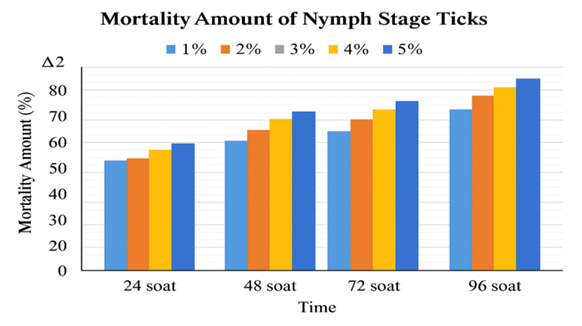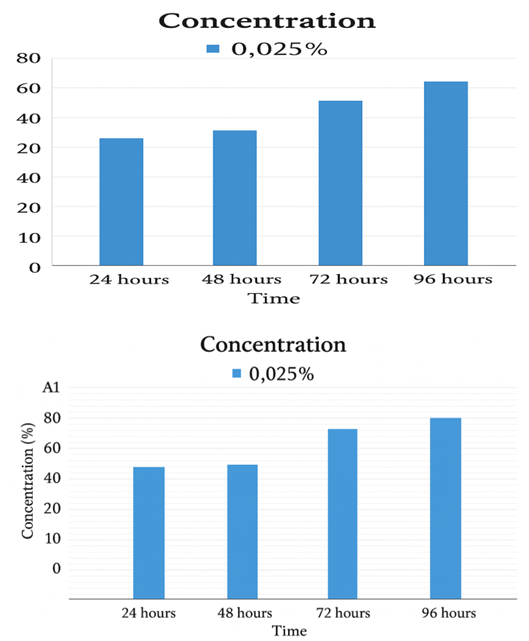-
Paper Information
- Next Paper
- Previous Paper
- Paper Submission
-
Journal Information
- About This Journal
- Editorial Board
- Current Issue
- Archive
- Author Guidelines
- Contact Us
International Journal of Genetic Engineering
p-ISSN: 2167-7239 e-ISSN: 2167-7220
2025; 13(6): 101-103
doi:10.5923/j.ijge.20251306.02
Received: May 7, 2025; Accepted: May 23, 2025; Published: Jun. 5, 2025

Evaluation of the Acaricidal Effectiveness of Bitter Almond (Amygdalus Communis L.) Alcoholic Extract Against Argas Persicus Ticks under Laboratory Conditions
Omonova N. R.1, Bobonazarov G. Ya.1, Shapaotov R. Q.2
1Karshi State University, Karshi, Uzbekistan
2Institute of Zoology, Academy of Sciences of the Republic of Uzbekistan, Tashkent, Uzbekistan
Correspondence to: Omonova N. R., Karshi State University, Karshi, Uzbekistan.
| Email: |  |
Copyright © 2025 The Author(s). Published by Scientific & Academic Publishing.
This work is licensed under the Creative Commons Attribution International License (CC BY).
http://creativecommons.org/licenses/by/4.0/

Laboratory experiments were conducted to evaluate the acaricidal effectiveness of bitter almond (Amygdalus communis L.) plant extract at concentrations ranging from 1% to 5% against Argas persicus ticks. The results demonstrated that concentrations between 3% and 5% of the alcoholic extract exhibited significantly high mortality rates in both the nymph and adult (imago) stages of the ticks. Specifically, the 96-hour mortality rate of the extract against nymphs reached up to 85% at 3% concentration and up to 95% at 5% concentration.
Keywords: Argas persicus, Tick, Nymph, Imago, Bitter almond, Extract, Cypermethrin
Cite this paper: Omonova N. R., Bobonazarov G. Ya., Shapaotov R. Q., Evaluation of the Acaricidal Effectiveness of Bitter Almond (Amygdalus Communis L.) Alcoholic Extract Against Argas Persicus Ticks under Laboratory Conditions, International Journal of Genetic Engineering, Vol. 13 No. 6, 2025, pp. 101-103. doi: 10.5923/j.ijge.20251306.02.
1. Introduction
- Due to the expansion of natural habitats by human activity, the distribution range of ticks parasitizing farm animals and poultry has shifted, resulting in increased diversity of synanthropic species [1,3]. Notably, most tick-borne diseases are zoonotic in nature, meaning they can be transmitted from various agricultural animals to humans through close contact [2,4]. Therefore, studying the distribution, ecological, and biological characteristics of ticks in detail, as well as developing effective control measures against them, remains a pressing issue [7,10].Currently, blood-sucking ticks are mainly controlled using insectoacaricides such as permethrin, cypermethrin, and organophosphorus compounds. However, the constant use of various synthetic acaricide pesticides has led to resistance in ticks. In addition, these chemical substances are considered harmful, as they can contaminate food products and pose risks to human health. In contrast, biological pesticides are environmentally friendly, more affordable, and in some cases, even more effective than chemical alternatives [5,6,9].Substances extracted from local plants that contain cyanogenic groups have relatively low toxicity, with an effect comparable to that of pyrethroids. These compounds are considered non-toxic to animals and poultry, and are primarily intended for the elimination of ectoparasites.The aim of this study was to characterize the acaricidal activity of alcoholic extracts of bitter almond (Amygdalus communis L.) at various concentrations and exposure durations against different developmental stages (nymph and adult) of Argas persicus ticks. Additionally, the acaricidal effectiveness of the chemical preparation “cypermethrin” was evaluated in comparison with the bitter almond extract under laboratory conditions.
2. Materials and Methods
- The research was conducted during the spring, summer, and autumn seasons from 2020 to 2024. Argas persicus ticks were collected from private poultry facilities located in Kamashi, Nishon, and Koson districts of the Kashkadarya region. To prepare the extract, bitter almond seeds were gathered from the mountainous and foothill areas of the Bostanlyk district in the Tashkent region.For experimental analysis, one kilogram of bitter almond seeds was selected. The seeds were blanched in boiling water for 1–2 minutes to remove the amniotic membrane, then pressed to extract the oil. For alcoholic extraction, the seeds were treated with 90% ethanol at a temperature of 70–80°C in a water bath for 40 minutes. The ratio of raw material to solvent was 1:10, and the seeds were soaked in ethanol for 24 hours. The extraction process was carried out in detail following the method developed by A.J. Khamidov [8].To determine the acaricidal effect of the bitter almond alcoholic extract, five different concentrations (1%, 2%, 3%, 4%, and 5%) were tested on both the nymph and adult (imago) stages of Argas persicus ticks. Each experiment was repeated three times. A total of 42 Petri dishes were used, each containing 20 tick specimens. The ticks were exposed to the respective acaricidal concentrations and observed at 24, 48, 72, and 96-hour intervals. In parallel, a control group was treated with distilled water (H₂O), and for comparative analysis, a 0.025% solution of the chemical acaricide cypermethrin was used.In total, 840 tick specimens were used in the experiments—420 nymphs and 420 adults. Of these, 600 ticks were exposed to the bitter almond extract, 120 were treated with cypermethrin, and 120 were used in the control group. All experimental procedures were carried out at a temperature of 26±3°C and a relative humidity of 81±1.5%.
3. Results
- The experimental findings demonstrated the acaricidal activity of both the bitter almond extract and the chemical acaricide cypermethrin against the nymph and adult stages of Argas persicus. The mortality rates of the ticks at different developmental stages are summarized below, comparing the effectiveness of the bitter almond extract to that of cypermethrin.Specifically, when observed over a 24-hour period, the 1% concentration of bitter almond extract resulted in a nymphal mortality rate of 50 ± 1.7%; at 48 hours – 60 ± 0.5%; at 72 hours – 65 ± 0.4%; and at 96 hours – 70 ± 0.2%.At 2% concentration, mortality rates were: 55 ± 1.9% (24 h), 65 ± 1.7% (48 h), 70 ± 0.5% (72 h), and 80 ± 0.5% (96 h). With 3% concentration, mortality reached 62 ± 1.9% (24 h), 69 ± 1.7% (48 h), 78 ± 0.5% (72 h), and 85 ± 0.5% (96 h).At 4% concentration, results were 70 ± 1.9% (24 h), 81 ± 1.7% (48 h), 88 ± 0.5% (72 h), and 93 ± 0.5% (96 h). The highest concentration, 5%, showed mortality of 74 ± 1.9% (24 h), 86 ± 1.7% (48 h), 90 ± 0.5% (72 h), and 95 ± 0.5% (96 h).In the adult (imago) stage, the 1% extract caused mortality of 42 ± 1.5% at 24 hours, 56 ± 0.5% at 48 hours, 68 ± 0.4% at 72 hours, and 75 ± 0.2% at 96 hours.At 2%, mortality was 47 ± 1.9% (24 h), 63 ± 1.7% (48 h), 71 ± 0.5% (72 h), and 78 ± 0.5% (96 h). At 3%, the rates were 54 ± 1.9% (24 h), 67 ± 1.7% (48 h), 74 ± 0.5% (72 h), and 81 ± 0.5% (96 h). The 4% concentration resulted in 66 ± 1.9% (24 h), 76 ± 1.7% (48 h), 84 ± 0.5% (72 h), and 88 ± 0.5% (96 h). Finally, the 5% extract caused mortality of 68 ± 1.9% (24 h), 80 ± 1.7% (48 h), 86 ± 0.5% (72 h), and 91 ± 0.5% (96 h). These experimental trials clearly indicate that the acaricidal efficacy of the bitter almond alcoholic extract was significantly higher at the nymph stage of Argas persicus (see Figure 1).
 | Figure 1 |
 | Figure 2 |
4. Conclusions
- Laboratory studies were conducted to determine the effectiveness of bitter almond alcoholic extract in concentrations ranging from 1% to 5% against the nymph and imago stages of Argas persicus. In particular, it was found that concentrations of 3% to 5% of bitter almond extract, as well as the 0.025% solution of the chemical "Cypermethrin" used for comparison, showed significantly high acaricidal activity against both developmental stages (nymph and imago) of the tick species.
 Abstract
Abstract Reference
Reference Full-Text PDF
Full-Text PDF Full-text HTML
Full-text HTML